Destinations: Desert Fortresses
Al-Jouf, Saudi Arabia

Some of Saudi Arabia’s most important ancient archaeological sites lie in the northwestern province of Al-Jouf, which is bordered on the south by the Nafud, one of the country’s two great deserts.
Until recently, these sites have been inaccessible to visitors. This began to change in 1998, however, when the Kingdom—as most Saudis call their country—opened its doors to foreign tourists who come as part of a group. I was one of the lucky ones.
According to Assyrian annals, King Sennacherib’s army penetrated into Al-Jouf in 688 B.C., attacking “Adumatu [present-day Domat Al-Jandal], the stronghold of the Arabs.” Around 550 B.C., the Babylonians led by king Nabonidus also captured Domat Al-Jandal and incorporated Al-Jouf into the Babylonian empire.
The Nabateans, who controlled the caravan routes between Arabia and the Mediterranean from the first century B.C. through the first century A.D., ruled from Petra in nearby Jordan. Domat Al-Jandal was one of their important trading centers because of its strategic position along the incense routes crossing northwest Arabia.
The Romans under Emperor Trajan annexed Nabatean lands in 106 A.D. Five hundred years later, when Islam swept across the Arabian peninsula, the prophet Mohammed himself led an expedition to Domat Al-Jandal.
Already a library member? Log in here.
Institution user? Log in with your IP address.

